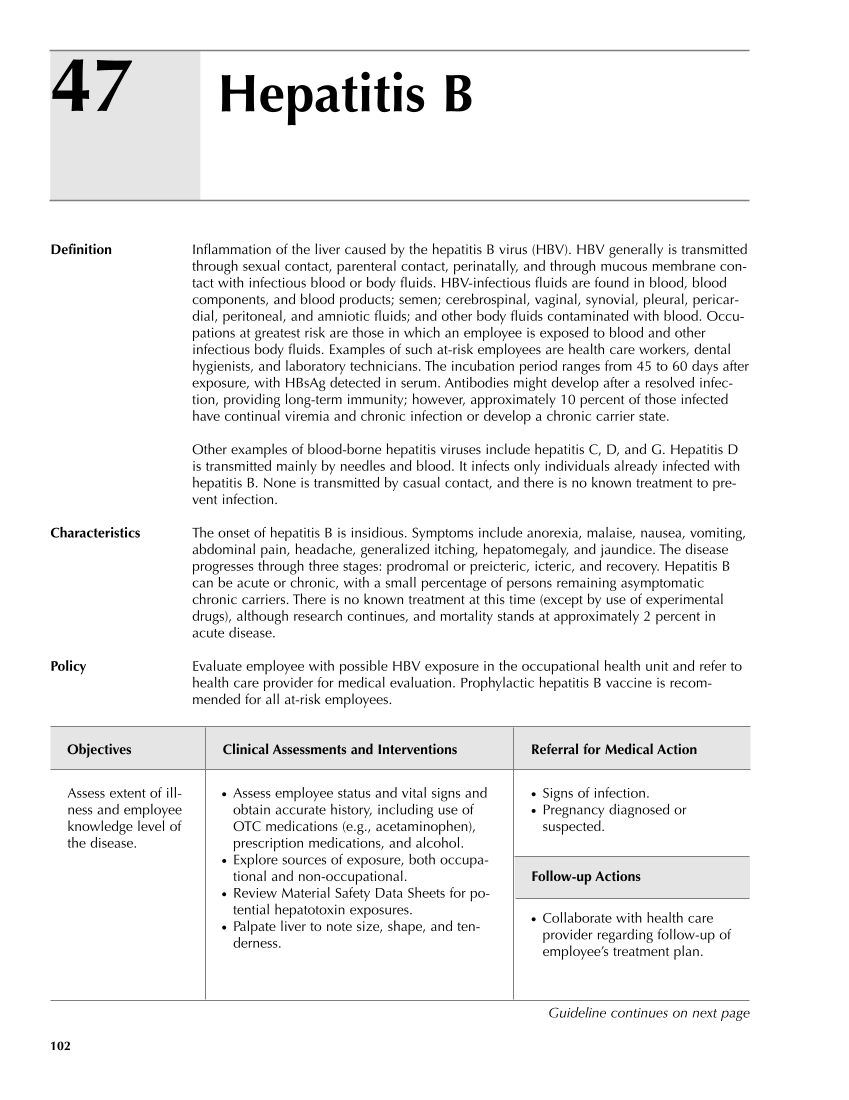47 102 Definition Inflammation of the liver caused by the hepatitis B virus (HBV). HBV generally is transmitted through sexual contact, parenteral contact, perinatally, and through mucous membrane con- tact with infectious blood or body fluids. HBV-infectious fluids are found in blood, blood components, and blood products semen cerebrospinal, vaginal, synovial, pleural, pericar- dial, peritoneal, and amniotic fluids and other body fluids contaminated with blood. Occu- pations at greatest risk are those in which an employee is exposed to blood and other infectious body fluids. Examples of such at-risk employees are health care workers, dental hygienists, and laboratory technicians. The incubation period ranges from 45 to 60 days after exposure, with HBsAg detected in serum. Antibodies might develop after a resolved infec- tion, providing long-term immunity however, approximately 10 percent of those infected have continual viremia and chronic infection or develop a chronic carrier state. Other examples of blood-borne hepatitis viruses include hepatitis C, D, and G. Hepatitis D is transmitted mainly by needles and blood. It infects only individuals already infected with hepatitis B. None is transmitted by casual contact, and there is no known treatment to pre- vent infection. Characteristics The onset of hepatitis B is insidious. Symptoms include anorexia, malaise, nausea, vomiting, abdominal pain, headache, generalized itching, hepatomegaly, and jaundice. The disease progresses through three stages: prodromal or preicteric, icteric, and recovery. Hepatitis B can be acute or chronic, with a small percentage of persons remaining asymptomatic chronic carriers. There is no known treatment at this time (except by use of experimental drugs), although research continues, and mortality stands at approximately 2 percent in acute disease. Policy Evaluate employee with possible HBV exposure in the occupational health unit and refer to health care provider for medical evaluation. Prophylactic hepatitis B vaccine is recom- mended for all at-risk employees. Objectives Clinical Assessments and Interventions Referral for Medical Action Hepatitis B ● Signs of infection. ● Pregnancy diagnosed or suspected. Follow-up Actions ● Collaborate with health care provider regarding follow-up of employee’s treatment plan. Assess extent of ill- ness and employee knowledge level of the disease. ● Assess employee status and vital signs and obtain accurate history, including use of OTC medications (e.g., acetaminophen), prescription medications, and alcohol. ● Explore sources of exposure, both occupa- tional and non-occupational. ● Review Material Safety Data Sheets for po- tential hepatotoxin exposures. ● Palpate liver to note size, shape, and ten- derness. Guideline continues on next page
Purchased from OEM Press by (ge corporate access). (C) 2013 OEM Health Information, Inc. All rights reserved.












































































































































































































































































































































































































































